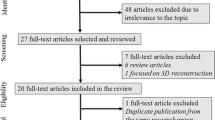Abstract
In the context of medical three-dimensional (3D) printing, in addition to 3D reconstruction from cross-sectional imaging, graphic design plays a role in developing and/or enhancing 3D-printed models. A custom prototype modular 3D model of the liver was graphically designed depicting segmental anatomy of the parenchyma containing color-coded hepatic vasculature and biliary tree. Subsequently, 3D printing was performed using transparent resin for the surface of the liver and polyamide material to develop hollow internal structures that allow for passage of catheters and wires. A number of concepts were incorporated into the model. A representative mass with surrounding feeding arterial supply was embedded to demonstrate tumor embolization. A straight narrow hollow tract connecting the mass to the surface of the liver, displaying the path of a biopsy device’s needle, and the concept of needle “throw” length was designed. A connection between the middle hepatic and right portal veins was created to demonstrate transjugular intrahepatic portosystemic shunt (TIPS) placement. A hollow amorphous structure representing an abscess was created to allow the demonstration of drainage catheter placement with the formation of pigtail tip. Percutaneous biliary drain and cholecystostomy tube placement were also represented. The skills of graphic designers may be utilized in creating highly customized 3D-printed models. A model was developed for the demonstration and simulation of multiple hepatobiliary interventions, for training purposes, patient counseling and consenting, and as a prototype for future development of a functioning interventional phantom.








Similar content being viewed by others
Abbreviations
- 3D:
-
Three-dimensional
- STL:
-
STereoLithography or Standard Tessellation Language
- TIPS:
-
Transjugular intrahepatic portosystemic shunt
References
Mitsouras D, Liacouras P, Imanzadeh A, Giannopoulos AA, Cai T, Kumamaru KK, George E, Wake N, Caterson EJ, Pomahac B, Ho VB, Grant GT, Rybicki FJ: Medical 3D printing for the radiologist. Radiographics 35:1965–1988, 2015
Giannopoulos AA, Steigner ML, George E, Barile M, Hunsaker AR, Rybicki FJ, Mitsouras D: Cardiothoracic applications of 3-dimensional printing. J Thorac Imaging 31:253–272, 2016
Zeng N, Tao H, Fang C, Fan Y, Xiang N, Yang J, Zhu W, Liu J, Guan T, Fang C, Xiang F: Individualized preoperative planning using three-dimensional modeling for Bismuth and Corlette type III hilar cholangiocarcinoma. World J Surg Oncol 14:44, 2016
Villard PF, Vidal FP, Cenydd L, Holbrey R, Pisharody S, Johnson S, Bulpitt A, John NW, Bello F, Gould D: Interventional radiology virtual simulator for liver biopsy. Int J CARS 9:255–267, 2014
Sekhar A, Sun MR, Siewert B: A tissue phantom model for training residents in ultrasound-guided liver biopsy. Acad Radiol 21:902–908, 2014
Xiang N, Fang C, Fan Y, Yang J, Zeng N, Liu J, Zhu W: Application of liver three-dimensional printing in hepatectomy for complex massive hepatocarcinoma with rare variations of portal vein: preliminary experience. Int J Clin Exp Med 8:18873–18878, 2015
Zein NN, Hanouneh IA, Bishop PD, Samaan M, Eghtesad B, Quintini C, Miller C, Yerian L, Klatte R: Three-dimensional print of liver for preoperative planning in living donor liver transplantation. Liver Transpl 19:1304–1310, 2013
Kong X, Nie L, Zhang H, Wang Z, Ye Q, Tang L, Huang W, Li J: Do 3D printing models improve anatomical teaching about hepatic segments to medical students? A randomized controlled study. World J Surg 40:1969–1976, 2016
Dhir V, Itoi T, Fockens P, Perez-Miranda M, Khashab MA, Seo DW, Yang AM, Lawrence KY, Maydeo A: Novel ex vivo model for hands-on teaching of and training in EUS-guided biliary drainage: creation of “Mumbai EUS” stereolithography/3D printing bile duct prototype (with videos). Gastrointest Endosc 81:440–446, 2015
Burdall OC, Makin E, Davenport M, Ade-Ajayi N: Three-dimensional printing to simulate laparoscopic choledochal surgery. J Pediatr Surg 51:828–831, 2016
Souzaki R, Kinoshita Y, Ieiri S, Hayashida M, Koga Y, Shirabe K, Hara T, Maehara Y, Hashizume M, Taguchi T: Three-dimensional liver model based on preoperative CT images as a tool to assist in surgical planning for hepatoblastoma in a child. Pediatr Surg Int 31:593–596, 2015
Javan R, Herrin D, Tangestanipoor A: Understanding Spatially Complex Segmental and Branch Anatomy Utilizing 3D Printing: Liver, Lung, Prostate, Coronary Arteries, and Circle of Willis. Academic Radiology. 23(9):1183–1189, 2016. doi: 10.1016/j.acra.2016.04.010
i. Materialise.com. <http://www.i.materialise.com>, Accessed April 9, 2016
Bernhard JC, Isotani S, Matsugasumi T, Duddalwar V, Hung AJ, Suer E, Baco E, Satkunasivam R, Djaladat H, Metcalfe C, Hu B, Wong K, Park D, Nguyen M, Hwang D, Bazargani ST, de Castro Abreu AL, Aron M, Ukimura O, Gill IS: Personalized 3D printed model of kidney and tumor anatomy: a useful tool for patient education. World J Urol 34:337–345, 2016
Stratasys.com. <http://www.stratasys.com/j750>, Accessed Jan 30, 2017
Javan R, Bansal M, Tangestanipoor A: A prototype hybrid gypsum-based 3D printed training model for CT-guided spinal pain management. Journal of Computer Assisted Tomography. 40(4):626–631, 2016. doi: 10.1097/RCT.0000000000000415
Acknowledgements
The authors would like to acknowledge Bahareh Sianati, MD, for assisting in gathering references.
Author information
Authors and Affiliations
Corresponding author
Rights and permissions
About this article
Cite this article
Javan, R., Zeman, M.N. A Prototype Educational Model for Hepatobiliary Interventions: Unveiling the Role of Graphic Designers in Medical 3D Printing. J Digit Imaging 31, 133–143 (2018). https://doi.org/10.1007/s10278-017-0012-4
Published:
Issue Date:
DOI: https://doi.org/10.1007/s10278-017-0012-4




